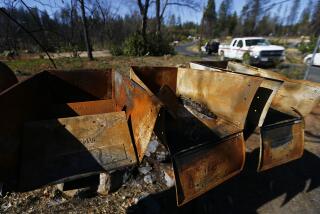Liability Rates Rise for Firms, Consumers
- Share via
The cost of insuring against lawsuits already has climbed for company directors in the wake of Enron Corp.’s meltdown. Now, liability insurance is becoming more expensive for others--including homeowners--as insurers get pickier about the risks they are willing to take.
Premiums for certain kinds of professional liability coverage are rising as much as 70%, and insurers are trimming coverage and dropping unprofitable customers, insurance brokers said.
Companies that paid $12,000 for $1 million of liability coverage for its directors and officers last year now pay $20,000 to $30,000, said Susanne Murray, national director for such coverage at insurance broker Willis Group Holdings Ltd.
The average insurance tab for company directors and officers is expected to rise an additional 35% this year, and some big public companies will face increases of 50% or more, said Murray, who co-authored a study of current liability-insurance market conditions.
Even liability insurance for nonbusiness risks, such as lawsuit protection for drivers and homeowners, is beginning to rise.
Rates for so-called umbrella or personal-liability policies, which offer lawsuit protection on top of a homeowner or auto policy, are rising nationwide from an average of $150 for $1 million of coverage last year to about $200 this year, said Michelle Kenney, director of underwriting for Fireman’s Fund in Novato, Calif.
A number of factors have collided to produce what insurers call a “hard market” for liability insurance, in which even steep price increases are sticking and insurance purchasers have little choice but to pay or go without coverage.
The Sept. 11 terrorist attacks, poor stock market returns, more class-action lawsuits, high-profile corporate bankruptcies such as those filed by Enron and Global Crossing Ltd. and years of price cuts have contributed to the current rate hikes, insurance experts said.
Premiums for all kinds of insurance had been gradually increasing before Sept. 11, as insurers realized that price wars had trimmed rates too far for the companies to remain profitable. More than a year of poor investment returns also were taking their toll.
“Insurance companies historically have operated at a slight loss, but they have been able to make up for it with investment income,” Kenney said. “Now they don’t have the same [leeway] to cover up that loss, and the [insurance] lines have to stand on their own.”
Those problems were exacerbated by the terrorist attacks. The giant reinsurance companies that are paying most of the $40-billion to $70-billion insurance tab for the tragedy have sharply raised the prices they charge insurers and reduced the available coverage, said Don Griffin, head of business and personal lines for the National Assn. of Independent Insurers.
Consumer advocates have warned that insurers may be taking advantage of the terrorist attacks to push through big premium increases. But other insurance experts say the price increases probably are overdue for liability insurance.
“The pricing was pretty much out of whack for a number of years,” said Murray of insurance broker Willis. “Prices were dropping by 15% a year and features were being added for free [to attract customers].”
Insurers also are spooked by a rising number of lawsuits and bigger settlements, said Fred Sklow, an insurance analyst for Standard & Poor’s.
The number of federal securities fraud class-action lawsuits filed last year hit a record--487--compared with the previous peak of 236 in 1998, according to the Stanford Securities Class Action Clearinghouse.
The bursting of the dot-com bubble and a record number of failed initial public offerings in 2000 helped increase the number of lawsuits. More lawsuits mean more claims on liability insurance as companies defend themselves.
Meanwhile, the Enron debacle has made insurers and their clients more aware of how much potential liability can be faced by a company’s directors and officers. Enron’s directors have been named in dozens of lawsuits filed by angry shareholders and employees.
Some accountants are feeling the heat as well after Andersen’s role as Enron’s auditor drew lawsuits and a federal indictment for alleged obstruction of justice.
Though the Big Five accounting firms generally are self-insured, liability rates for second-tier firms that audit public companies generally are on the rise, said John Kenny, senior underwriting officer for Aon Corp., which provides insurance for more than 25% of the accounting market.
Higher rates have yet to trickle down to smaller accounting firms, said Mark Cheffers, owner of AccountingMalpractice.com, which tracks insurance trends.
In California, where most local accounting firms are covered by mutual insurer Camico, accountants still pay $3,000 to $7,000 for $1 million of errors-and-omissions insurance to cover any professional mistakes, said Ron Klein, general counsel for the company.
More to Read
Inside the business of entertainment
The Wide Shot brings you news, analysis and insights on everything from streaming wars to production — and what it all means for the future.
You may occasionally receive promotional content from the Los Angeles Times.










